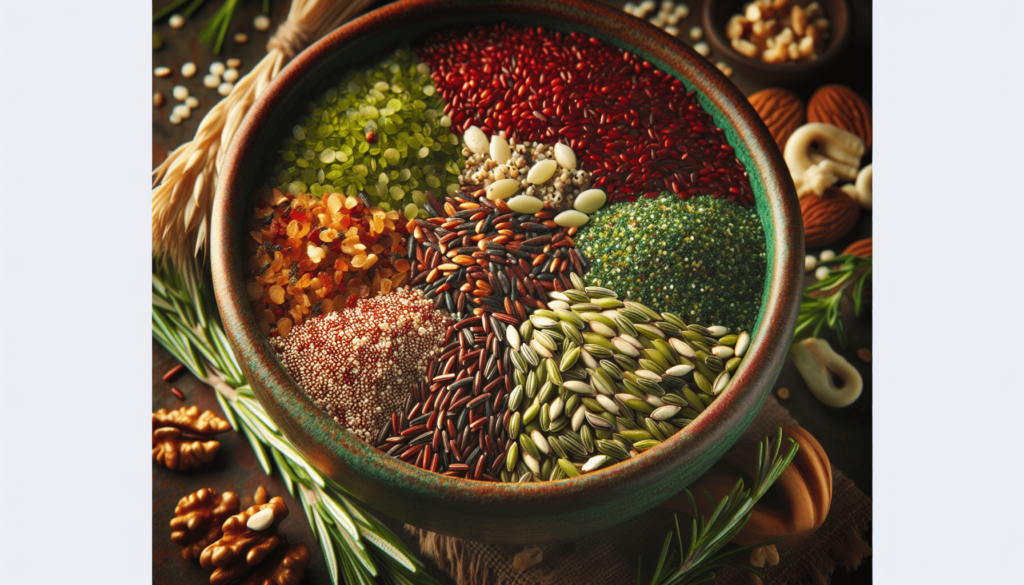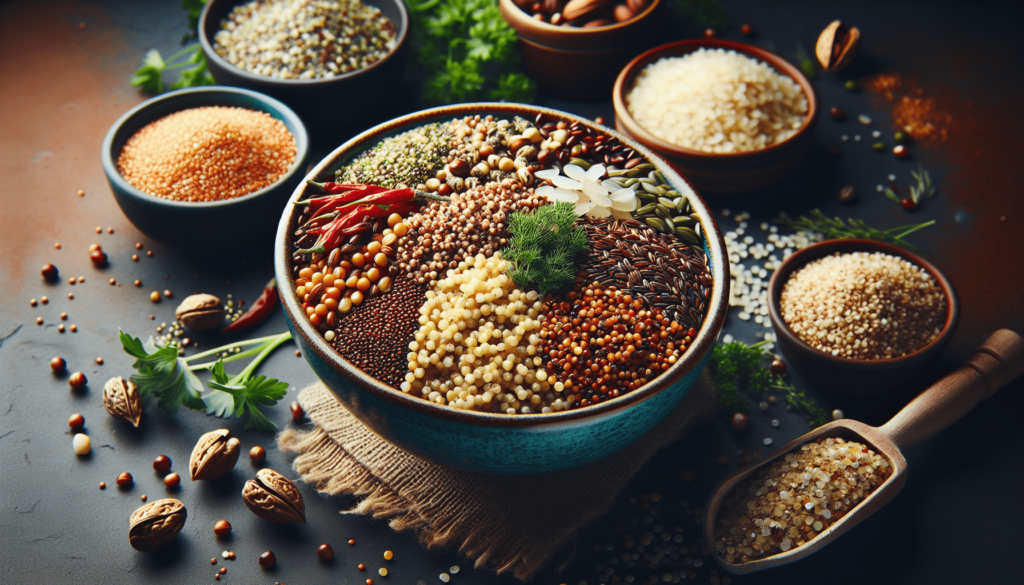Have you ever tried incorporating unconventional grains into your diet? You might be surprised to learn about the many health benefits and unique flavors they can offer. In this article, we will explore some delicious recipes using unconventional grains that you can easily add to your meal rotation. So, let’s dive in and discover the world of nutritious and tasty alternatives!
What are Unconventional Grains?
Unconventional grains refer to varieties of grains that are not as commonly consumed as wheat, rice, or oats. These grains are often ancient or heirloom varieties that offer a range of nutritional benefits. They can also add diversity to your diet and introduce new flavors and textures to your meals.
The Health Benefits of Unconventional Grains
Incorporating unconventional grains into your diet can provide a wide array of health benefits. These grains are often rich in nutrients such as fiber, protein, vitamins, and minerals. Additionally, many unconventional grains are gluten-free, making them an excellent choice for individuals with gluten sensitivities or celiac disease.
Types of Unconventional Grains
There are numerous varieties of unconventional grains available, each with its unique nutritional profile and culinary potential. Here are a few examples of unconventional grains that you may want to consider adding to your pantry:
Amaranth
Amaranth is a highly nutritious grain that has been cultivated for thousands of years. It is rich in protein, fiber, and essential amino acids. Amaranth has a nutty flavor and a chewy texture, making it a versatile ingredient in both sweet and savory dishes.
Sorghum
Sorghum is a gluten-free grain that is packed with antioxidants, vitamins, and minerals. It has a mild, slightly sweet flavor that pairs well with a variety of ingredients. Sorghum can be used in salads, pilafs, soups, and even desserts.
Teff
Teff is a tiny grain that is native to Ethiopia and Eritrea. It is a good source of iron, calcium, and protein. Teff has a mild, nutty flavor and can be used to make porridge, bread, and injera, a traditional Ethiopian flatbread.
Farro
Farro is an ancient grain that has been enjoyed for centuries in Mediterranean cuisine. It is high in fiber, protein, and antioxidants. Farro has a chewy texture and a nutty flavor that works well in salads, soups, and grain bowls.

Delicious Recipes Using Unconventional Grains
Now that you are familiar with some popular unconventional grains let’s explore some recipes that showcase their versatility and deliciousness:
Amaranth Breakfast Bowl
Ingredients:
- 1/2 cup amaranth
- 1 cup almond milk
- 1 teaspoon cinnamon
- 1 tablespoon honey
- 1/4 cup sliced almonds
- Fresh berries for topping
Instructions:
- In a saucepan, combine the amaranth, almond milk, and cinnamon.
- Bring the mixture to a boil, then reduce heat and simmer for 20-25 minutes, stirring occasionally.
- Once the amaranth is cooked and the mixture has thickened, stir in the honey.
- Divide the amaranth into bowls and top with sliced almonds and fresh berries.
This amaranth breakfast bowl is a nutritious and satisfying way to start your day. The combination of creamy amaranth, sweet honey, and crunchy almonds is sure to please your taste buds.
Sorghum Salad with Roasted Vegetables
Ingredients:
- 1 cup sorghum
- 2 cups vegetable broth
- 1 small eggplant, diced
- 1 zucchini, diced
- 1 red bell pepper, sliced
- 2 tablespoons olive oil
- 2 tablespoons balsamic vinegar
- Salt and pepper to taste
- Fresh herbs for garnish
Instructions:
- Cook the sorghum in vegetable broth according to package instructions.
- Preheat the oven to 400°F (200°C).
- In a bowl, toss the diced eggplant, zucchini, and red bell pepper with olive oil, balsamic vinegar, salt, and pepper.
- Spread the vegetables on a baking sheet and roast for 20-25 minutes, or until tender and slightly caramelized.
- In a large bowl, combine the cooked sorghum and roasted vegetables.
- Garnish with fresh herbs before serving.
This sorghum salad is a flavorful and satisfying dish that is perfect for lunch or as a side dish at dinner. The combination of chewy sorghum and roasted vegetables creates a hearty and delicious meal.
Teff Chocolate Chip Cookies
Ingredients:
- 1 cup teff flour
- 1/2 teaspoon baking soda
- 1/4 teaspoon salt
- 1/2 cup coconut oil, melted
- 1/2 cup coconut sugar
- 1 teaspoon vanilla extract
- 1 egg
- 1/2 cup chocolate chips
Instructions:
- Preheat the oven to 350°F (180°C) and line a baking sheet with parchment paper.
- In a bowl, whisk together the teff flour, baking soda, and salt.
- In a separate bowl, cream together the melted coconut oil, coconut sugar, and vanilla extract.
- Beat in the egg until well combined.
- Gradually add the dry ingredients to the wet ingredients, mixing until a dough forms.
- Fold in the chocolate chips.
- Use a cookie scoop to portion out the dough onto the prepared baking sheet.
- Bake for 10-12 minutes, or until the cookies are golden brown.
- Let the cookies cool on the baking sheet before serving.
These teff chocolate chip cookies are a delightful treat that combines the earthy flavor of teff with the sweetness of chocolate. They are perfect for satisfying your sweet tooth while enjoying the health benefits of teff.
Farro Mushroom Risotto
Ingredients:
- 1 cup farro
- 4 cups vegetable broth
- 2 tablespoons olive oil
- 1 onion, diced
- 2 cloves garlic, minced
- 8 oz mushrooms, sliced
- 1/2 cup white wine
- 1/4 cup grated Parmesan cheese
- Salt and pepper to taste
- Fresh parsley for garnish
Instructions:
- In a saucepan, bring the vegetable broth to a simmer.
- In a separate large skillet, heat olive oil over medium heat.
- Add the diced onion and sauté until translucent.
- Stir in the minced garlic and sliced mushrooms, cooking until the mushrooms are tender.
- Add the farro to the skillet and toast for 2-3 minutes.
- Pour in the white wine and simmer until the liquid is absorbed.
- Begin adding the vegetable broth, 1/2 cup at a time, stirring frequently until the farro is cooked and the mixture is creamy.
- Stir in the grated Parmesan cheese and season with salt and pepper.
- Garnish with fresh parsley before serving.
This farro mushroom risotto is a comforting and flavorful dish that showcases the nutty flavor and chewy texture of farro. The addition of mushrooms and Parmesan cheese adds depth and richness to this hearty meal.
Conclusion
Incorporating unconventional grains into your diet can open up a world of culinary possibilities and health benefits. By trying out different recipes that feature grains like amaranth, sorghum, teff, and farro, you can diversify your meals and discover new flavors and textures. Whether you are looking to add more nutrients to your diet or simply expand your culinary horizons, experimenting with unconventional grains is a delicious and rewarding experience. So why not give some of these recipes a try and enjoy the many benefits of incorporating unconventional grains into your cooking repertoire!


